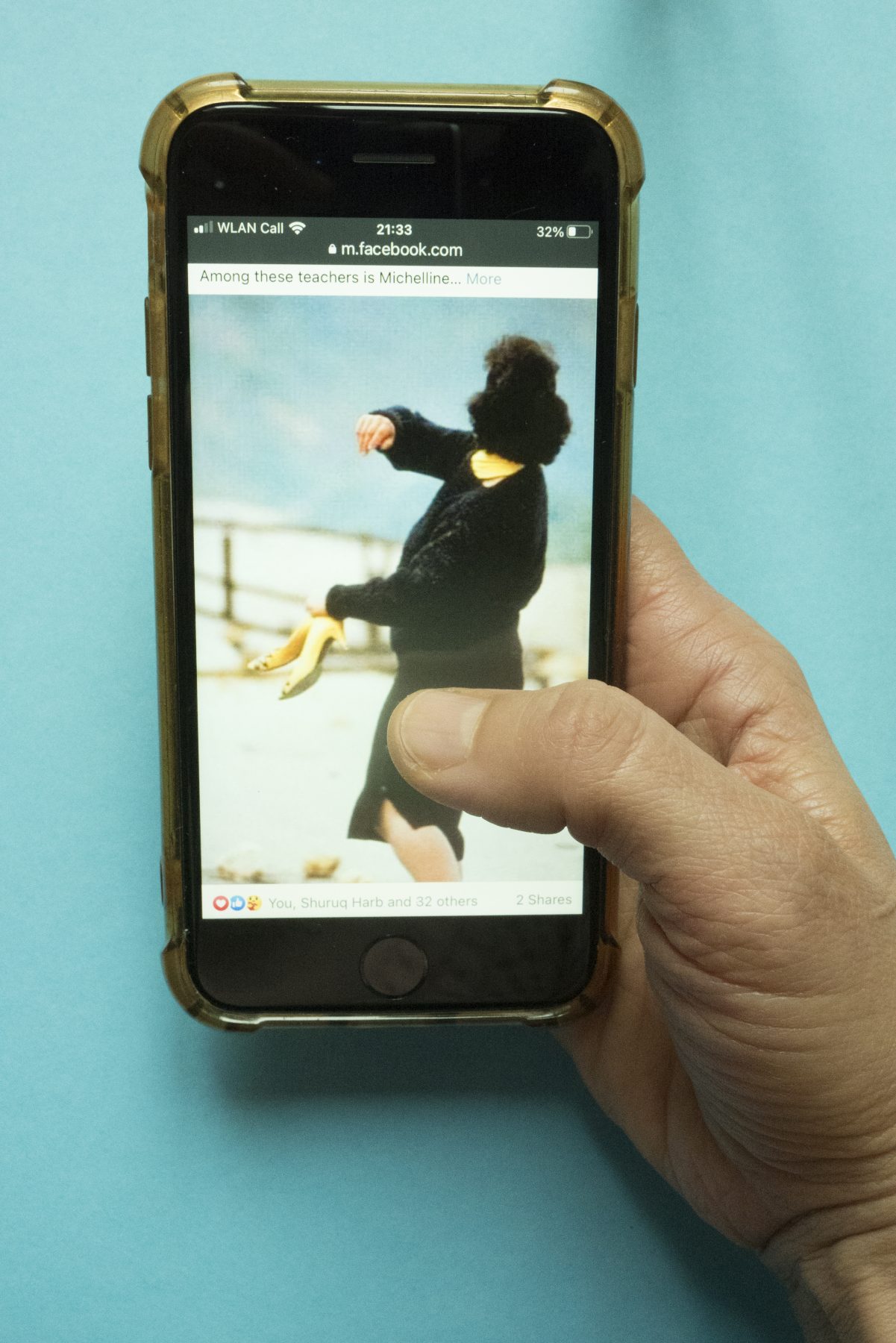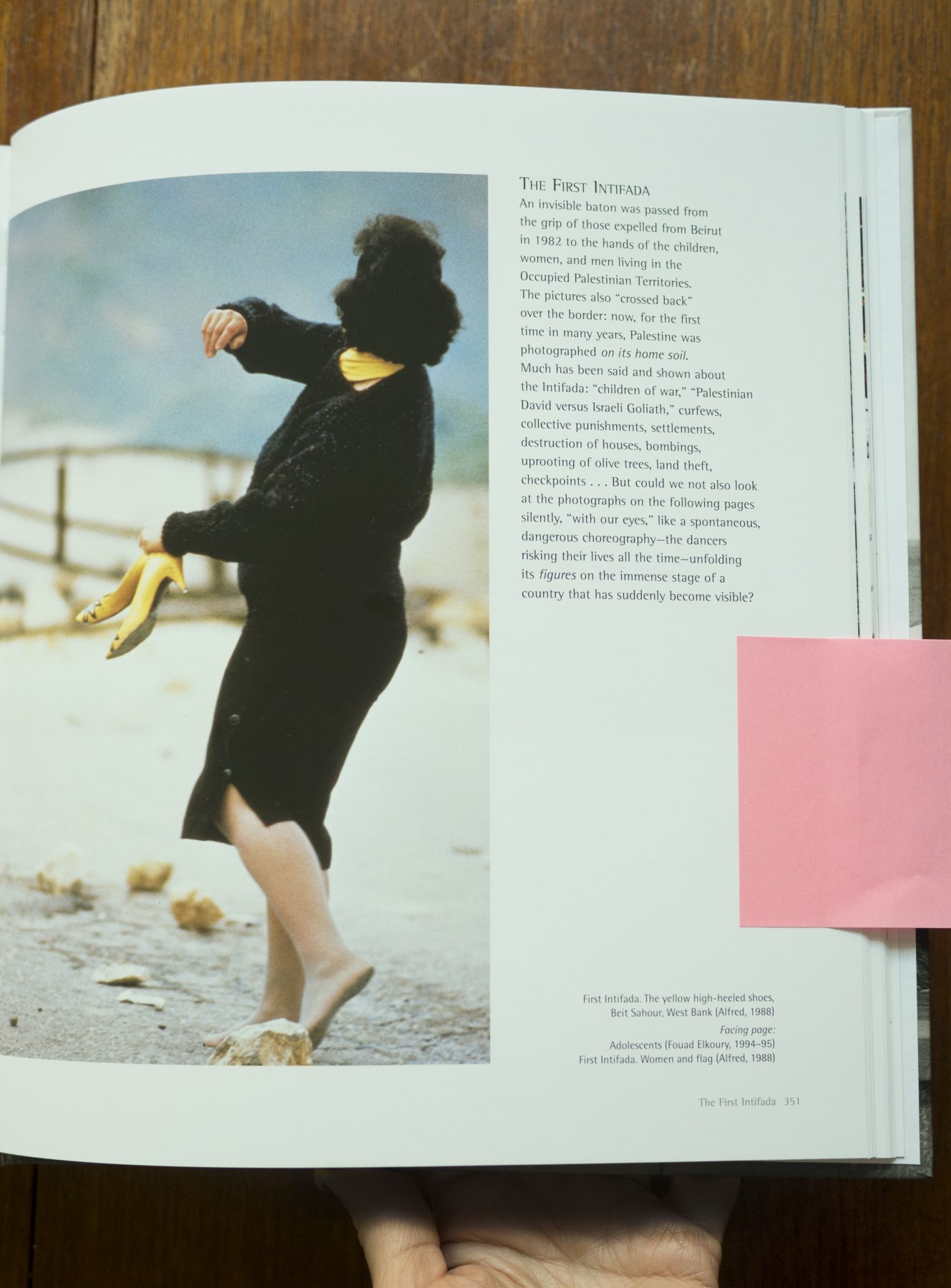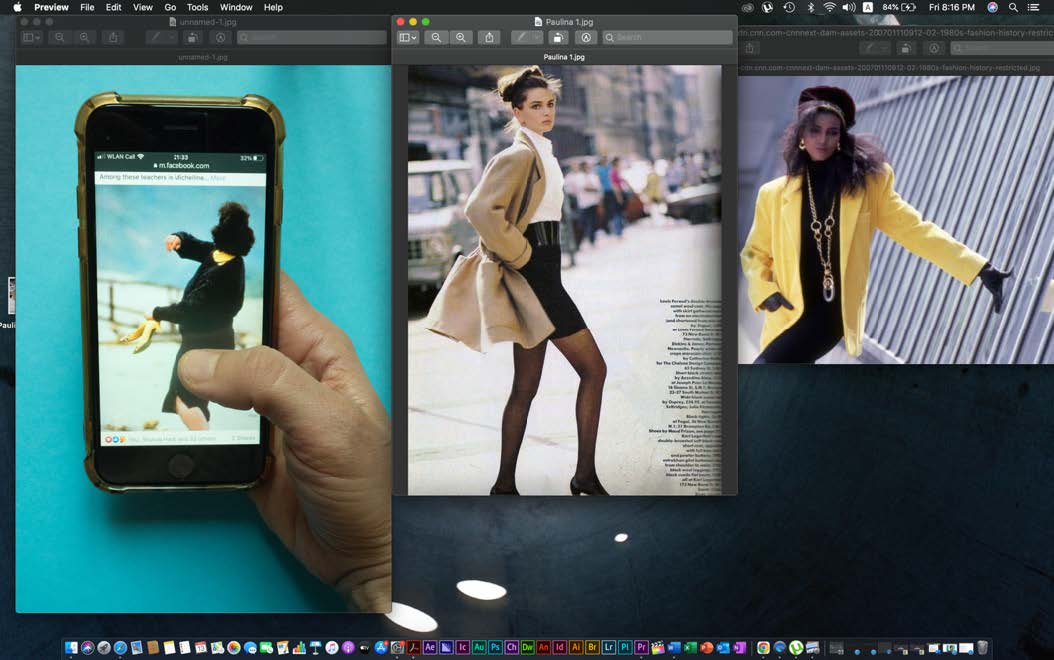An image in question with Zeina G. Halabi, Sherene Seikaly, Shuruq Harb, Irmgard Emmelhainz, Hanan Toukan, Wendy Shaw, and Sa’ed Atshan

Oraib Toukan (2022), Michellen Awad, still from a phone, courtesy the artist.
From: Oraib Toukan
Subject: An image in question
Date: 12 May 2022 at 11:10:35 CEST
Dear all,
I do hope you are well. I am wondering if you would be willing to respond briefly with a question I am posing to a few of us thinking through images in our work. On December 8 the historian and colleague Sherene Seikaly posted the above image on facebook of Michellen Awad and tagged the Palestinian Feminist Collective with the following text: “Today on the anniversary of the #Intifada we honor all the Palestinians who have taught us the texture of feminism, what it looks like on the ground, how it is based in love. Among these teachers is Michelline Awad, pictured here in her iconic yellow heels, who explains: “It was an uprising from the heart.”
A few of us *liked* this iconic image. I am wondering if you would be willing to share your thoughts on what it is that draws one into this frame. Alfred Yaghobzadeh took this picture in 1988, of Michelin Awad, a teacher, who was leaving mass at a church in Beit Sahour not far from Bethlehem on a day in 1988. Upon seeing younger people confronting Israeli tanks, Awad took off her heels to throw stones on Israeli occupation forces. It was featured with the below text in Elias Sanbar’s chapter on the First Intifada in his seminal book The Palestinians.
Please let me know your interest. I would love to publish your response however brief, formal or informal.
Warmly,
Oraib

Oraib Toukan (2022), Michellen Awad, still from a book, courtesy the artist.
From: Zeina G. Halabi
Subject: Re: An image in question
Date: 20 May 2022 at 19:17:27 CEST
When the ordinary is a stone thrown at that which denies life, holding yellow pumps matched with a yellow turtleneck seems like an effortless accomplishment, almost an event, so extraordinary as it affirms the life it clings to.
From: Irmgard Emmelhainz
Subject: Re: An image in question
Date: 21 May 2022 at 00:42:57 CEST
Usually, teachers and women rise up or resist through quiet or subtle gestures that unfold in time: by transmitting knowledge, raising consciousness, through steadfastness, weaving networks of solidarity, as opposed to physical gestures or direct confrontation. Heteropatriarchy does not grant us the right to be violent. We are out of place when we revolt physically, although our bodies are fiery sites for revolt. It seems to me that by taking off her yellow heels, to join the uprising on the street, she has suspended momentarily “feminity,” to claim a site of struggle that is not normally granted to women. Putting herself at risk, performing a gesture that is her right, yet remains symbolic.
From: Sherene Seikaly
Subject: Re: An image in question
Date: 13 May 2022 at 00:01:59 CEST
You were on your way to church that day. You had assembled your outfit carefully: a black sweater, a black skirt, a bright yellow scarf, and brave loud matching heels. It was just another Sunday. But then it wasn’t. It never could be on land occupied and brutalized, on grounds shifting under the pressure of a force much larger than you hell bent on confiscation, humiliation, extraction. But you were hell bent too. Hell bent from the heart. And with that careful, artful extension of your beautiful wrist, you lodged a stone that would render your figure iconic, that would position you in a tradition of past and present teachers who impart lessons on staying put and holding ground with and through love.
From: Hanan Toukan
Subject: Re: An image in question
Date: 13 May 2022 at 10:07:30 CEST
The colours. The utter unabashed femininity in the photo, the forte, the skill and grace by which she demonstrates in that one moment and all at once how utterly futile colonial subjugation is. It never wins, a pair of yellow pumps can tell that story.
From: Wendy Shaw
Subject: Re: An image in question
Date: 14 May 2022 at 11:08:17 CEST
The photograph is like an overlay of so many photographs. The 2001 photograph of Edward Said lobbing a stone; the 2018 photograph of a Palestinian protestor wielding a flag and a slingshot; the photograph, two days ago, of Shireen Abu Aqlah, the Palestinian-American journalist slain by an Israeli sniper, face down on the ground in her bullet-proof vest and helmet. In the face of an inverted reality, to throw a stone… to get dressed up for church, to engage in the world asserting the continuity of life, and then to take off one’s ‘cute’ yellow pumps and throw a stone on the way home exemplifies the refusal to surrender, the refusal to disappear. The refusal to give up everyday life, looking good, taking pleasure, it is all part of the act of resistance. The resistance occurs in the raising of the hand, the throwing of the stone (real or metaphorical). Stones of truth are the most unbearable.
From: Sa’ed Atshan
Subject: Re: An image in question
Date: 23 May 2022 at 07:33:04 CEST
We, Palestinians, and our allies, celebrate, and we mourn. We honor the women of Palestine who are the backbone of our society. As a Palestinian cis male queer feminist, I am proud to come from a long lineage of strong women: great-grandmothers, grandmothers, mother, aunts, cousins, nieces, sisters, and neighbors. My sense of spiritual rootedness stems from their love and examples.
Micheline Awwad’s legacy gives us courage as we grieve the murder of Shireen Abu Akleh in the present. Both are Palestinian Christian women who embody bearing witness to Israeli occupation. They manifest resistance to oppression through word and deed. Awwad and Abu Akleh have become symbols, not only across Palestine, but around the world.
There is tremendous beauty and power in Palestinian femininity. Awwad’s color-coordinated bright yellow heels and scarf look to the future, even in the face of potential harm or death. Abu Akleh consistently carried herself with elegance as a journalist in occupied Palestine, even as she took risks standing before the camera to capture the realities of Palestinian suffering. The memories and resilience of Awwad and Abu Akleh resonate far and wide, touching the hearts of all who care about peace and justice in Palestine and beyond.
From: Shuruq Harb
Subject: Re: An image in question
Date: 13 May 2022 at 19:19:16 CEST
She is a body in motion, a perfect balance.
She is a dance, in her ability to multi-task.
She is effortlessly more than one thing at once, synchronizing different activities.
She is iconic 80s fashion (in style).
She just came out of mass (in religion).
She just threw a stone on a tank (in resistance).
She is barefoot (in spontaneity).
She is a freedom fighter (with no dress code).
She is ready (it does not matter what moment you catch her in).
And there is no such thing as being caught in the wrong shoes!

Shuruq Harb on Michellen Awad (Oraib Toukan, 2022), still from Harb’s desktop, courtesy the artist.
Oraib Toukan is an artist and scholar currently based in Berlin.